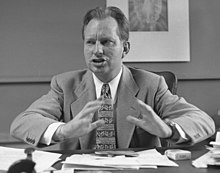
Back L. Ron Hubbard Afrikaans ل. رون هوبارد Arabic ل. رون هوبارد ARZ Лафает Рональд Хаббард Bashkir L. Ron Hubbard BCL Лафает Рональд Хабард Byelorussian Лафает Рональд Габард BE-X-OLD Л. Рон Хъбард Bulgarian L. Ron Hubbard Catalan ل.رۆن ھۆبارد CKB
L. Ron Hubbard | |
|---|---|
 Hubbard in 1950 | |
| Born | Lafayette Ronald Hubbard March 13, 1911 Tilden, Nebraska, U.S. |
| Died | January 24, 1986 (aged 74) Creston, California, U.S. |
| Other names | LRH |
| Education | George Washington University (dropped out) |
| Occupation |
|
| Known for | Inventor of Scientology |
| Notable work | |
| Criminal charges |
|
| Criminal penalty | Fine of ₣35,000 and four years in prison (unserved) |
| Spouses | |
| Children | 7, including Ronald, Diana and Quentin |
| Relatives | Jamie DeWolf (great-grandson) |
| Military career | |
| Service | United States Navy |
| Years of service |
|
| Rank | Lieutenant |
| Commands | USS YP-422 and USS PC-815 |
| Battles / wars |
|
| Awards | |
| Signature | |
| Part of a series of |
| L. Ron Hubbard biographies |
|---|
|
|
| More |
| Part of a series on |
| Scientology |
|---|
 |
|
| Controversies |
| More |
Lafayette Ronald Hubbard (March 13, 1911 – January 24, 1986) was an American author and the founder of Scientology. A prolific writer of pulp science fiction and fantasy novels in his early career, in 1950 he authored Dianetics: The Modern Science of Mental Health and established organizations to promote and practice Dianetics techniques. Hubbard created Scientology in 1952 after losing the intellectual rights to his literature on Dianetics in bankruptcy. He would lead the Church of Scientology – variously described as a cult,[1] a new religious movement, or a business – until his death in 1986.
Born in Tilden, Nebraska, in 1911, Hubbard spent much of his childhood in Helena, Montana. While his father was posted to the U.S. naval base on Guam in the late 1920s, Hubbard traveled to Asia and the South Pacific. In 1930, Hubbard enrolled at George Washington University to study civil engineering but dropped out in his second year. He began his career as an author of pulp fiction and married Margaret Grubb, who shared his interest in aviation.
Hubbard was an officer in the Navy during World War II, where he briefly commanded two ships but was removed from command both times. The last few months of his active service were spent in a hospital, being treated for a variety of complaints. In 1953, the first churches of Scientology were founded by Hubbard. In 1954 a Scientology church in Los Angeles was founded, which became the Church of Scientology International. Hubbard added organizational management strategies, principles of pedagogy, a theory of communication and prevention strategies for healthy living to the teachings of Scientology.[2] As Scientology came under increasing media attention and legal pressure in a number of countries during the late 1960s and early 1970s, Hubbard spent much of his time at sea as "commodore" of the Sea Organization, a private, quasi-paramilitary Scientologist fleet.
Hubbard returned to the United States in 1975 and went into seclusion in the California desert after an unsuccessful attempt to take over the town of Clearwater, Florida. In 1978, Hubbard was convicted of fraud after he was tried in absentia by France. In the same year, 11 high-ranking members of Scientology were indicted on 28 charges for their role in the Church's Snow White Program, a systematic program of espionage against the United States government. One of the indicted was Hubbard's wife Mary Sue Hubbard; he himself was named an unindicted co-conspirator. Hubbard spent the remaining years of his life in seclusion, attended to by a small group of Scientology officials.
Following his 1986 death, Scientology leaders announced that Hubbard's body had become an impediment to his work and that he had decided to "drop his body" to continue his research on another plane of existence. The Church of Scientology describes Hubbard in hagiographic terms, though many of his autobiographical statements were fictitious. Sociologist Stephen Kent has observed that Hubbard "likely presented a personality disorder known as malignant narcissism."[3]
- ^ Kent, Stephen A. (2001). "Brainwashing Programs in The Family/Children of God and Scientology". In Zablocki, Benjamin; Robbins, Thomas (eds.). Misunderstanding Cults: Searching for Objectivity in a Controversial Field. University of Toronto Press. pp. 349–358. ISBN 978-0-8020-8188-9.
- ^ Dericquebourg, Régis (2017). "Scientology: From the Edges to the Core". Nova Religio. 20 (4): 5–12. doi:10.1525/nr.2017.20.4.5. ISSN 1092-6690.
- ^ Lane, J., & Kent, S. A. (2008). "Malignant narcissism, L. Ron Hubbard, and Scientology's policies of narcissistic rage". Trans. as Politiques de rage et Narcissisme Malin. Criminologie, 41(2), 117-55.